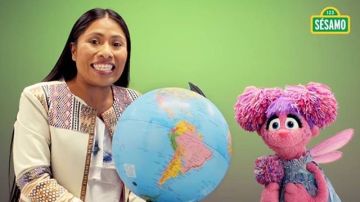Yalitza Aparicio’s Plaza Sésamo Appearance Is What Every Young Brown Girl Needs
For a lot of young Brown Latinas like myself, whether of Afro-Latina or indigenous descent, finding stars on television or in films — even Spanish-language programs — with people that looked like us didn’t happen often

Photo: Instagram/cinematropical
For a lot of young Brown Latinas like myself, whether of Afro-Latina or indigenous descent, finding stars on television or in films — even Spanish-language programs — with people that looked like us didn’t happen often. The few Latinas we’d see in Hollywood or even in Mexican novelas were often white-passing, which is why Yalitza Aparicio’s special appearance on Plaza Sésamo (The Spanish version of Sesame Street) on International Women’s Day was so very important.
For decades, we had Maria, a brown-skinned Puerto Rican woman with naturally curly hair on Sesame Street, played by Sonia Manzano and it was significant for many of us. In fact, for many young Latinas, Manzano’s character was the first Latina on television that made them feel reflected and seen. Aparicio’s recent appearance was just as meaningful.
In the brief segment, Aparicio is seen with muppet, Abby Cadabby. The two had an adorable and inspiring dialogue around the importance of following your dreams. Aparicio’s advise to the puppet was one a lot of young Latinas could benefit from hearing,
“If you believe in yourself and work really hard, you’ll be able to accomplish all of your dreams,” she said.
Aparicio’s role in the Oscar-winning film Roma, directed by Mexican director Alfonso Cuarón, was significant for a lot of Latinas — Indigenous Mexicanas especially. The former teaching college student whose life changed after attending a casting in her hometown of Tlaxiaco, Mexico, didn’t think people that looked like her could ever land a lead role in a movie. Not only did her performance blow folks away, eventually leading to an Oscar nomination but Aparicio also became the second Mexican actress and the first Indigenous woman to be nominated for an Oscar.
She also landed on the cover of Vogue Mexico, something Aparicio didn’t expect — often told growing up that she was “the wrong color.” Her appearance on that magazine was in many ways a milestone for a Latina of Indigenous descent. But her success meant a lot to so many brown-skinned Latinas who haven’t otherwise seen Latinas who look like them on the cover of fashion magazines. It has in many ways made her a role model for women and Indigenous people in Mexico.
“It shouldn’t matter what you’re into, how you look — you can achieve whatever you aspire to,” she has said and she’s absolutely right. It shouldn’t matter but unfortunately, we live in a society — in a world — where it still does. Even fellow Mexicans have cruelly criticized Aparicio for her brown skin and Indigenous features. Just last week, Mexican comedian Yeka Rosales thought it was okay to do a skit on the show La Parodia, making fun of Aparicio. In the skit, Rosales is seen with her face painted in brown face while rocking a wide prosthetic nose. Not only was it disturbing but also served as evidence of the colorism issue that still very much exists within the Latinx community.
Little brown girls need to see more Aparicio on television, in film, in theater, and on the cover of magazines, to remind them that they are in fact, beautiful, worthy to be seen, worthy to be heard, respected and valued.

















